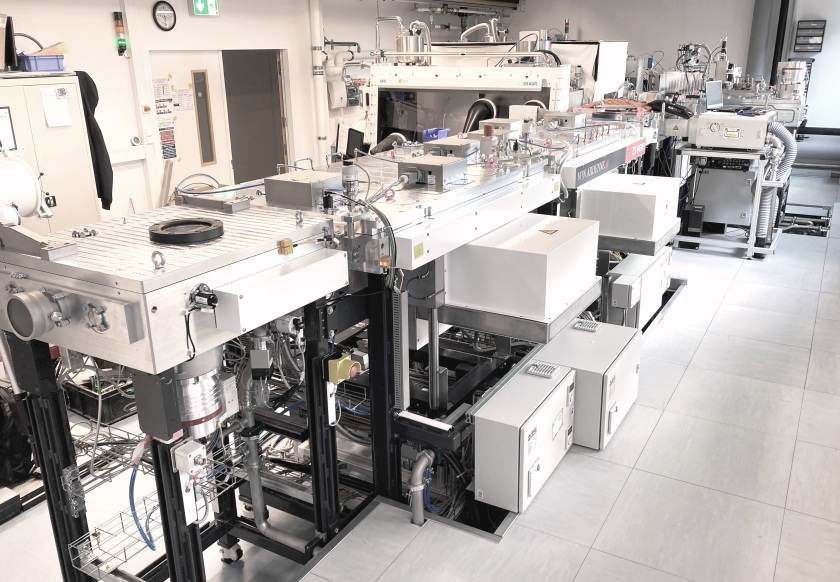On the way to mass production: perovskite silicon tandem cells

The cluster facility operated at HZB allows to produce large-area perovskite/silicon tandem solar cells. This facility, the only one of its kind in the world, helps to develop new industry-related processes, materials and solar cells. © B. Stannowski / HZB
In order to transfer tandem solar cells from laboratory scale to production, HZB is cooperating with the solar module manufacturer Meyer Burger, which has great expertise in heterojunction technology (HJT) for silicon modules. Within the framework of this cooperation, mass production-ready silicon bottom cells based on heterojunction technology are to be combined with a top cell based on perovskite technology.
Meyer Burger is a manufacturer of high-quality solar modules based on silicon heterojunction technology (HJT). Meyer Burger's research and development team has already developed HJT cells in recent years together with Bernd Stannowski's team at the Helmholtz-Zentrum Berlin.
The HZB has great expertise in the field of perovskite solar cells. Recently, laboratory tandem solar cells combining heterojunction and perovskite have achieved record efficiencies of over 31 percent, largely due to the work of Steve Albrecht's group. However, such record-breaking tandem cells have only the laboratory-standard areas of 1 cm² and are partly produced with processes that are not scalable.
"We are therefore delighted to be cooperating with Meyer Burger to transfer this fantastic technology into application," says Bernd Stannowski, who heads the cooperation at HZB. A new cluster facility (KOALA) will also be used. This globally unique facility, funded by the German Federal Ministry of Economics and Climate Protection (BMWK) and the Federal Ministry of Education and Research (BMBF), makes it possible to produce perovskite/silicon tandem solar cells in a vacuum on industry-standard large wafers.
"Meyer Burger manufactures in Europe and thus creates high-quality jobs. In doing so, the company is exploiting technologies that were developed in Europe," says Rutger Schlatmann, director of the Photovoltaics Competence Centre Berlin (PVcomB) at HZB. The new cooperation agreement is set to run for three years.
red.
https://www.helmholtz-berlin.de/pubbin/news_seite?nid=24366;sprache=en
- Copy link
-
Optical innovations for solar modules - which are the most promising?
In 2023, photovoltaic systems generated more than 5% of the world’s electrical energy and the installed capacity doubles every two to three years. Optical technologies can further increase the efficiency of solar modules and open up new applications, such as coloured solar modules for facades. Now, 27 experts provide a comprehensive overview of the state of research and assess the most promising innovations. The report, which is also of interest to stakeholders in funding and science management, was coordinated by HZB scientists Prof. Christiane Becker and Dr. Klaus Jäger.
-
Samira Aden joins ETIP PV - The European Technology & Innovation Platform for Photovoltaics ESG Working Group
Samira Jama Aden, Architect Design Research, has joined the ETIP PV - The European Technology & Innovation Platform for Photovoltaics working group “Environmental, Social and Governance (ESG)”.
-
BESSY II: Magnetic ‘microflowers’ enhance magnetic fields locally
A flower-shaped structure only a few micrometres in size made of a nickel-iron alloy can concentrate and locally enhance magnetic fields. The size of the effect can be controlled by varying the geometry and number of 'petals'. This magnetic metamaterial developed by Dr Anna Palau's group at the Institut de Ciencia de Materials de Barcelona (ICMAB) in collaboration with her partners of the CHIST-ERA MetaMagIC project, has now been studied at BESSY II in collaboration with Dr Sergio Valencia. Such a device can be used to increase the sensitivity of magnetic sensors, to reduce the energy required for creating local magnetic fields, but also, at the PEEM experimental station, to study samples under much higher magnetic fields than currently possible.
